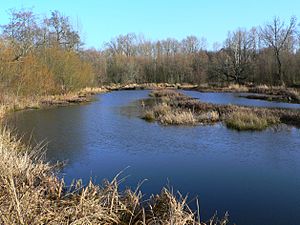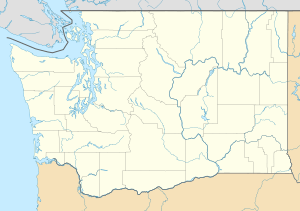Billy Frank Jr. Nisqually National Wildlife Refuge facts for kids
Quick facts for kids Billy Frank Jr. Nisqually National Wildlife Refuge |
|
|---|---|
|
IUCN Category IV (Habitat/Species Management Area)
|
|
 |
|
| Location | Thurston and Pierce counties, Washington, USA |
| Nearest city | Lacey, WA |
| Area | 4,529.21 acres (18.3291 km2) |
| Established | 1974 |
| Named for | Billy Frank, Jr. |
| Visitors | 137,000 (in 2004) |
| Governing body | United States Fish and Wildlife Service |
| Website | Billy Frank Jr. Nisqually NWR |
The Billy Frank Jr. Nisqually National Wildlife Refuge is a special place for animals and nature. It's managed by the United States Fish and Wildlife Service. You can find it on the Nisqually River Delta, close to Puget Sound in Washington. It's easy to get to, located right off Interstate 5, between the cities of Tacoma and Olympia. This refuge helps protect many different kinds of wildlife.
Contents
History of the Nisqually Refuge
This wildlife refuge was created in 1974. It covers about 12.6 square kilometers (about 4.8 square miles). The main goal was to provide safe homes and nesting spots for waterfowl and other birds that travel long distances.
The refuge includes many different types of natural areas. These include a protected estuary (where fresh and saltwater mix), salt marshes, and open mudflats. There are also freshwater marshes, open grasslands, and riverbank woodlands with brush. Another smaller part of the refuge, about 3.2 square kilometers (1.2 square miles), is found along the Black River. This river flows into the Chehalis River. A local nature lover named Margaret McKenny helped make sure this important area was saved.
On December 18, 2015, President Barack Obama signed a special law. This law renamed the refuge in honor of Billy Frank, Jr.. He was a respected leader of the Nisqually tribe and worked hard to protect their treaty rights. He passed away in 2014. The law also created the Medicine Creek Treaty National Memorial inside the refuge. This memorial remembers the important Treaty of Medicine Creek.
Wildlife at Nisqually Refuge
The Nisqually River Delta is a very special place. It is Washington state's largest estuary that has not been greatly changed by people. Here, the fresh water of the Nisqually River meets the salty water of the south Puget Sound. This mix creates many unique environments. These areas are full of nutrients and natural resources. They provide homes for over 300 different kinds of fish and wildlife.
In 1904, a long wall called the Brown Farm Dike was built. It was about five miles long and protected farmland from the ocean tides. However, this dike caused a problem. It blocked off important areas that young fish, birds, and marine mammals like harbor seals needed to live.
To fix this, a big project began to restore the estuary. In 2009, a new dike was built behind the old one. Then, about four miles of the old Brown Farm Dike were removed. This allowed the ocean tides to flow back into 762 acres of land. This helped bring back the natural estuary environment.
Fish and Sea Life
The refuge is home to 24 different kinds of fish. They live in three main areas: the river, the estuary (where fresh and salt water mix), or the Nisqually Reach near the coast. You can find many fish here, including large numbers of fall Chinook salmon, starry flounder, and shiner perch.
The salt marshes and mudflats are found outside the dikes. These areas are rich in nutrients. They are home to animals like clams, crabs, shrimp, and worms. These small creatures are food for many birds, such as ducks, gulls, and herons.
Birds and Land Animals
Over 20,000 birds use the freshwater marshes and grasslands. These birds belong to 275 different migrating species. They come here to breed, rest, or spend the winter. Common types of birds include raptors (like hawks), shorebirds, and songbirds. Larger animals, such as hawks and coyotes, hunt in the grasslands. They find food like mice and voles there.
The riparian woodland and brush habitats are also full of life. Many amphibians, mammals, and reptiles live in these areas.
Images for kids



